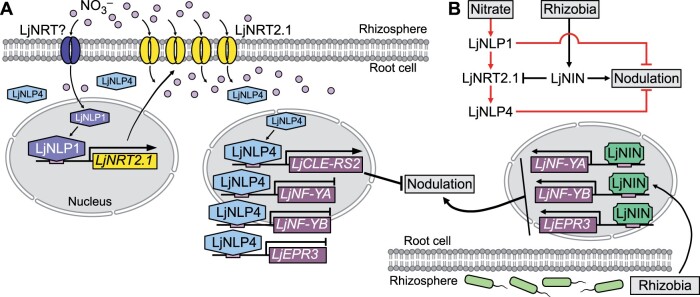Figure 11.
Model for the nitrate-induced control of nodulation in L. japonicus. A, A model of the LjNLP1-LjNRT2.1-LjNLP4 signaling pathway, which controls nodulation in response to nitrate. Nitrate taken up from the soil leads to activation of LjNLP1, thereby enabling LjNLP1 to induce the expression of LjNRT2.1. LjNRT2.1 then plays a role in enhancing nitrate uptake/transport. LjNLP4 nuclear localization is triggered by the enhanced influx of nitrate. LjNLP4 subsequently induces the expression of LjCLE-RS2, a negative regulator of nodulation. LjNLP4 also represses the expression of genes for positive regulators of nodulation, including LjNF-YA, LjNF-YB, and LjEPR3, by interfering with LjNIN’s role in inducing these genes (Nishida et al., 2021). The resultant altered expression of these symbiotic genes acts synergistically to negatively regulate nodulation. B, A simplified model. In addition to the pathway including LjNRT2.1, LjNLP1 has a different downstream pathway to negatively regulate nodulation. Expression of LjNIN, a positive regulator of nodulation, is induced by rhizobial infection, and LjNIN has a role to block the LjNLP1-dependent expression of LjNRT2.1. Red indicates nitrate-related regulation.

